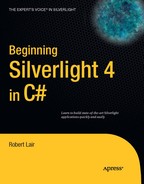There are many ways to learn a new technology such as Silverlight. For starters, Microsoft has gotten better and better with the documentation it releases with its programming technologies, and employee blogs and technology sites such as http://www.silverlight.net help by supplementing that documentation. Moreover, you can get information at a number of widely used forums where many experts participate, and, of course, you can always purchase training if you have the cash flow to justify it. While all of these are great options, many people still like to purchase a book on the technology. But with so many books on the market, how do you know which is best?
My own philosophy about learning a new technology is that there is no better way than to actually try it out for yourself. That's why I wrote Beginning Silverlight 4 in C# as a number of step-by-step, walk-through tutorials that give you hands-on experience with the different topics and get you started developing Silverlight applications on your own.
This book is for application developers who want to get started with Silverlight 4. It assumes you have some experience developing applications using technologies related to Microsoft's Visual Basic, ASP, or .NET, and have worked with Microsoft Visual Studio. You should be familiar with JavaScript, C#, and XML.
Each chapter focuses on a particular area of Silverlight and contains one or more "Try It Out" exercises that let you apply what you've learned. Here's brief guide to what you'll find in each chapter:
Chapter 1, "Welcome to Silverlight 4," introduces you to RIAs and Silverlight. You'll also learn about the tools used in developing Silverlight-enabled applications.
Chapter 2, "Introduction to Visual Studio 2010," presents Visual Studio 2010 and the important new features it offers. In this chapter, you'll build your first Silverlight application.
Chapter 3, "Layout Management in Silverlight," discusses Silverlight's flexible layout management system, which lets you specify how controls will appear in your applications. You'll find in-depth descriptions of Silverlight's layout management controls.
Chapter 4, "Silverlight Controls," introduces the common controls that are provided with Silverlight. You'll work with these controls throughout the book.
Chapter 5, "Data Binding and Silverlight List Controls," delves into the Silverlight controls that display lists of data, and looks at how to bind data to these controls. You'll see that these controls are flexible and can show data in unique ways.
Chapter 6, "Silverlight Toolkit," discusses the Silverlight Toolkit, an open source project that extends the Silverlight control set to include a number a controls, themes, and frameworks that can help you be more productive as a Silverlight developer.
Chapter 7, "Data Access and Networking," describes how data access in Silverlight applications works compared with traditional applications. It then explores mechanisms for accessing data in Silverlight applications, focusing on the use of web services.
Chapter 8, "Navigation Framework," looks at building Silverlight applications that allow users to navigate through different pages, creating an experience similar to browsing through different pages of a web site
Chapter 9, "Isolated Storage in Silverlight," covers localized storage in Silverlight, which is handled by its isolated storage feature. You'll learn how to store user-specific data for your application and have that data persist over browser instances.
Chapter 10, "System Integration and Device Support," covers how Silverlight applications can support notifications, integrate with legacy COM applications and libraries, access to a user's web camera and microphone, and be enabled as a drop target.
Chapter 11, "Introduction to Expression Blend," gets you started with Microsoft Expression Blend, which lets you edit XAML documents visually.
Chapter 12, "Styling in Silverlight," describes how you can control the styles of your Silverlight application's user interface elements. You'll see how to define style properties inline using both Visual Studio and Expression Blend, as well as how to use Silverlight styles.
Chapter 13, "Transformations and Animation," shows you how to create animations in Silverlight. You'll see how Expression Blend helps you create complex animations and transformations.
Chapter 14, "Custom Controls," explains the basics of creating custom controls in Silverlight. You'll learn when it's appropriate to write custom controls in Silverlight, and how to build a custom control that has several different states.
Chapter 15, "Printing in Silverlight," discusses how to add printing functionality to Silverlight applications.
Chapter 16, "Deployment," covers the deployment and configuration of Silverlight applications, as well as how to enable out-of-browser support.
By the time you finish this book, you'll have a firm foundation in Silverlight, and you'll be able to create your own Silverlight-enabled applications.
